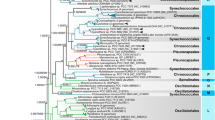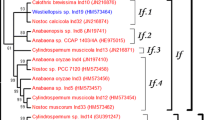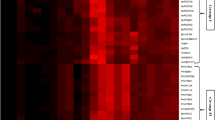Abstract
Proteobacteria is one of the largest and phenotypically most diverse divisions within the domain bacteria. Due to the economic importance, this phylum demands an urgent need for a clear and scientifically sound classification system to streamline their characterization. The goal of our study was to carefully reevaluate the current system of classification and suggest changes wherein necessary. Phylogenetic trees of 84 Proteobacteria were constructed using single gene-based phylogeny involving 16S rRNA genes and protein sequences of 85 conserved genes, whole genome-based phylogenetic tree using CVtree3.0, amino acid Identity matrix tree, and concatenated tree with aforementioned conserved genes. The results of our study confirm the polyphyletic relationship between Desulfurella acetivorans, a Deltaproteobacteria with Epsilonproteobacteria. The group Syntrophobacterales was found to be polyphyletic with respect to Desulfarculus baarsii and the group Thiotrichales was found to be splitting in different phylogenetic trees. Placement of phylogenetic groups belonging to Rhodocyclales, Oceonospirilalles, and Chromatiales is controversial and requires further study and revisions. Based on our analysis, we strongly support reclassification of Magnetococcales as a separate class Etaproteobacteria. From our results, we conclude that concatenated trees of conserved proteins are a more accurate method for phylogenetic analysis, as compared to other methods used.





Similar content being viewed by others
References
Gupta RS (2000) The phylogeny of proteobacteria: relationships to other eubacterial phyla and eukaryotes. FEMS Microbiol Rev 24(4):367–402
Stackebrandt E, Murray RGE, Truper HG (1988) Proteobacteria classis nov. a name for the phylogenetic taxon that includes the "Purple Bacteria and Their Relatives”. Int J Syst Bacteriol 38:321–325
Murray R, Brenner D, Colwell R, De Vos P, Goodfellow M, Grimont P et al (1990) Report of the ad hoc committee on approaches to taxonomy within the proteobacteria. Int J Syst Bacteriol 40:213–215
Woese CR (1987) Bacterial evolution. Microbiol Rev 51(2):221–271
Ji B, Zhang SD, Zhang WJ, Rouy Z, Alberto F, Santini CL et al (2017) The chimeric nature of the genomes of marine magnetotactic coccoid-ovoid bacteria defines a novel group of Proteobacteria. Environ Microbiol 19(3):1103–1119
Lin W, Zhang W, Zhao X, Roberts AP, Paterson GA, Bazylinski DA et al (2018) Genomic expansion of magnetotactic bacteria reveals an early common origin of magnetotaxis with lineage-specific evolution. ISME J 12(6):1508–1519
Shin N-R, Whon TW, Bae J-W (2015) Proteobacteria: microbial signature of dysbiosis in gut microbiota. Trends Biotechnol 33(9):496–503
Rizzatti G, Lopetuso LR, Gibiino G, Binda C, Gasbarrini A (2017) Proteobacteria: a common factor in human diseases. Biomed Res Int 2017:9351507
Maurin M, Raoult D (1999) Q fever. Clin Microbiol Rev 12(4):518–553
Munoz-Gomez SA, Hess S, Burger G, Lang BF, Susko E, Slamovits CH et al (2019) An updated phylogeny of the Alphaproteobacteria reveals that the parasitic Rickettsiales and Holosporales have independent origins. Elife. https://doi.org/10.7554/eLife.42535
Boden R, Hutt LP, Rae AW (2017) Reclassification of Thiobacillus aquaesulis (Wood & Kelly, 1995) as Annwoodia aquaesulis gen. nov., comb. nov., transfer of Thiobacillus (Beijerinck, 1904) from the Hydrogenophilales to the Nitrosomonadales, proposal of Hydrogenophilalia class. nov. within the “Proteobacteria”, and four new families within the orders Nitrosomonadales and Rhodocyclales. Int J Syst Evol Microbiol 67(5):1191–1205
Williams KP, Gillespie JJ, Sobral BW, Nordberg EK, Snyder EE, Shallom JM et al (2010) Phylogeny of gammaproteobacteria. J Bacteriol 192(9):2305–2314
Janda JM, Abbott SL (2021) The changing face of the family Enterobacteriaceae (Order: “Enterobacterales”): new members, taxonomic issues, geographic expansion, and new diseases and disease syndromes. Clin Microbiol Rev. https://doi.org/10.1128/CMR.00174-20
Waite DW, Vanwonterghem I, Rinke C, Parks DH, Zhang Y, Takai K et al (2018) Erratum: addendum: comparative genomic analysis of the class epsilonproteobacteria and proposed reclassification to Epsilonbacteraeota (phyl. Nov.). Front Microbiol 9:772
Waite DW, Chuvochina M, Pelikan C, Parks DH, Yilmaz P, Wagner M et al (2020) Proposal to reclassify the proteobacterial classes Deltaproteobacteria and Oligoflexia, and the phylum Thermodesulfobacteria into four phyla reflecting major functional capabilities. Int J Syst Evol Microbiol 70(11):5972–6016
Emerson D, Rentz JA, Lilburn TG, Davis RE, Aldrich H, Chan C et al (2007) A novel lineage of proteobacteria involved in formation of marine Fe-oxidizing microbial mat communities. PLoS ONE 2(7):e667
McAllister S, Moore R, Gartman A, Luther G, Emerson D, Chan C (2019) The Fe(II)-oxidizing Zetaproteobacteria: historical, ecological and genomic perspectives. FEMS Microbiol Ecol. https://doi.org/10.1093/femsec/fiz015
Williams KP, Kelly DP (2013) Proposal for a new class within the phylum Proteobacteria, Acidithiobacillia classis nov., with the type order Acidithiobacillales, and emended description of the class Gammaproteobacteria. Int J Syst Evol Microbiol 63(8):2901–2906
Moya-Beltran A, Beard S, Rojas-Villalobos C, Issotta F, Gallardo Y, Ulloa R et al (2021) Genomic evolution of the class Acidithiobacillia: deep-branching Proteobacteria living in extreme acidic conditions. ISME J 15(11):3221–3238
Nakai R, Nishijima M, Tazato N, Handa Y, Karray F, Sayadi S et al (2014) Oligoflexus tunisiensis gen. nov., sp. Nov., a Gram-negative, aerobic, filamentous bacterium of a novel proteobacterial lineage, and description of Oligoflexaceae fam. Nov., Oligoflexales ord. nov. and Oligoflexia classis nov. Int J Syst Evol Microbiol 64(Pt 10):3353–3359
Hahn MW, Schmidt J, Koll U, Rohde M, Verbarg S, Pitt A et al (2017) Silvanigrella aquatica gen. nov., sp. nov., isolated from a freshwater lake, description of Silvanigrellaceae fam. nov. and Silvanigrellales ord. nov., reclassification of the order Bdellovibrionales in the class Oligoflexia, reclassification of the families Bacteriovoracaceae and Halobacteriovoraceae in the new order Bacteriovoracales ord. nov., and reclassification of the family Pseudobacteriovoracaceae in the order Oligoflexales. Int J Syst Evol Microbiol 67(8):2555–2568
Yoon SH, Ha SM, Kwon S, Lim J, Kim Y, Seo H et al (2017) Introducing EzBioCloud: a taxonomically united database of 16S rRNA gene sequences and whole-genome assemblies. Int J Syst Evol Microbiol 67(5):1613–1617
Lemoine F, Correia D, Lefort V, Doppelt-Azeroual O, Mareuil F, Cohen-Boulakia S et al (2019) NGPhylogeny.fr: new generation phylogenetic services for non-specialists. Nucleic Acids Res 47(W1):W260–W265
Consortium TU (2018) UniProt: a worldwide hub of protein knowledge. Nucleic Acids Res 47(D1):D506–D515
Zuo G, Hao B (2015) CVTree3 web server for whole-genome-based and alignment-free prokaryotic phylogeny and taxonomy. Genom Proteomics Bioinform 13(5):321–331
Li Q, Xu Z, Hao B (2010) Composition vector approach to whole-genome-based prokaryotic phylogeny: success and foundations. J Biotechnol 149(3):115–119
Tamura K, Stecher G, Peterson D, Filipski A, Kumar S (2013) MEGA6: Molecular Evolutionary Genetics Analysis version 6.0. Mol Biol Evol 30(12):2725–2729
Felsenstein J (1989) PHYLIP—Phylogeny Inference Package (Version 3.2). Cladistics 5:164–166
Ciccarelli FD, Doerks T, von Mering C, Creevey CJ, Snel B, Bork P (2006) Towards automatic reconstruction of a highly resolved tree of life. Science 311:1283–1287
Galtier N (2007) A model of horizontal gene transfer and the bacterial phylogeny problem. Syst Biol 56(4):633–642
Prakash O, Verma M, Sharma P, Kumar M, Kumari K, Singh A et al (2007) Polyphasic approach of bacterial classification—an overview of recent advances. Indian J Microbiol 47(2):98–108
Devulder G, Pérouse de Montclos M, Flandrois JPA (2005) multigene approach to phylogenetic analysis using the genus Mycobacterium as a model. Int J Syst Evol Microbiol 55:293–302
Garnier F, Gerbaud G, Courvalin P, Galimand M (1997) Identification of clinically relevant viridans group streptococci to the species level by PCR. J Clin Microbiol 35(9):2337–2341
Guo Y, Zheng W, Rong X, Huang Y (2008) A multilocus phylogeny of the Streptomyces griseus 16S rRNA gene clade: use of multilocus sequence analysis for streptomycete systematics. Int J Syst Evol Microbiol 58:149–159
Shivannavar CT, Katoch VM, Sharma VD, Patil MA, Katoch K, Bharadwaj VP et al (1996) Determination of mycobacterial phylogeny on the basis of immunological relatedness of superoxide dismutases. Int J Syst Bacteriol 46(4):1164–1169
Verma M, Lal D, Kaur J, Saxena A, Kaur J, Anand S et al (2013) Phylogenetic analyses of phylum Actinobacteria based on whole genome sequences. Res Microbiol 164(7):718–728
Verma M, Kulshrestha S, Puri A (2017) Genome sequencing. Methods Mol Biol 1525:3–33
Rainey FA, Toalster R, Stackebrandt E (1993) Desulfurella acetivorans, a thermophilic, acetate-oxidizing and sulfur-reducing organism, represents a distinct lineage within the proteobacteria. Syst Appl Microbiol 16(3):373–379
Nakai R, Fujisawa T, Nakamura Y, Baba T, Nishijima M, Karray F et al (2016) Genome sequence and overview of Oligoflexus tunisiensis Shr3(T) in the eighth class Oligoflexia of the phylum Proteobacteria. Stand Genom Sci 11:90
Waite DW, Vanwonterghem I, Rinke C, Parks DH, Zhang Y, Takai K et al (2017) Comparative genomic analysis of the class Epsilonproteobacteria and proposed reclassification to Epsilonbacteraeota (phyl. Nov.). Front Microbiol 8:682
Kalyuzhnyi SV, Shestakova NM, Tourova TP, Poltaraus AB, Gladchenko MA, Trukhina AI et al (2010) Phylogenetic analysis of a microbial community involved in anaerobic oxidation of ammonium nitrogen. Microbiology 79(2):237–246
Melnyk R, Coates J (2015) The perchlorate reduction genomic island: mechanisms and pathways of evolution by horizontal gene transfer. BMC Genom 16:1–11
Canback B, Tamas I, Andersson SG (2004) A phylogenomic study of endosymbiotic bacteria. Mol Biol Evol 21(6):1110–1122
Adeolu M, Alnajar S, Naushad S, Gupta RS (2016) Genome-based phylogeny and taxonomy of the “Enterobacteriales”: proposal for Enterobacterales ord. nov. divided into the families Enterobacteriaceae, Erwiniaceae fam. nov., Pectobacteriaceae fam. nov., Yersiniaceae fam. nov., Hafniaceae fam. nov., Morganellaceae fam. nov., and Budviciaceae fam. nov. Int J Syst Evol Microbiol 66(12):5575–5599
Williams K, Gillespie J, Sobral B, Nordberg E, Snyder E, Shallom J et al (2010) Phylogeny of Gammaproteobacteria. J Bacteriol 192:2305–2314
Caro-Quintero A, Konstantinidis KT (2015) Inter-phylum HGT has shaped the metabolism of many mesophilic and anaerobic bacteria. ISME J 9(4):958–967
Dubinsky EA, Conrad ME, Chakraborty R, Bill M, Borglin SE, Hollibaugh JT et al (2013) Succession of hydrocarbon-degrading bacteria in the aftermath of the deepwater horizon oil spill in the Gulf of Mexico. Environ Sci Technol 47(19):10860–10867
Gao B, Mohan R, Gupta RS (2009) Phylogenomics and protein signatures elucidating the evolutionary relationships among the Gammaproteobacteria. Int J Syst Evol Microbiol 59(Pt 2):234–247
Gadagkar SR, Rosenberg MS, Kumar S (2005) Inferring species phylogenies from multiple genes: concatenated sequence tree versus consensus gene tree. J Exp Zool B Mol Dev Evol 304(1):64–74
Doolittle WF (1999) Phylogenetic classification and the universal tree. Science 284(5423):2124–2129
Acknowledgements
Authors acknowledge Prof. C. Sheela Reddy, Principal, Sri Venkateswara College, University of Delhi for encouraging to conduct this research.
Author information
Authors and Affiliations
Contributions
MV conceived the idea of this research question. VS, AV, ALMJ, AK, NB, RY, AB, AG, SL performed the analysis and drafted the manuscript. MV supported the interpretation of data from the literature and the revision of the manuscript. MV, AV, ALMJ, AK, PS critically reviewed the manuscript. All authors read and approved the final manuscript.
Corresponding author
Ethics declarations
Conflict of interest
The authors declare that there are no conflicts of interest.
Additional information
Publisher's Note
Springer Nature remains neutral with regard to jurisdictional claims in published maps and institutional affiliations.
Supplementary Information
Below is the link to the electronic supplementary material.
Rights and permissions
About this article
Cite this article
Sharma, V., Vashishtha, A., Jos, A.L.M. et al. Phylogenomics of the Phylum Proteobacteria: Resolving the Complex Relationships. Curr Microbiol 79, 224 (2022). https://doi.org/10.1007/s00284-022-02910-9
Received:
Accepted:
Published:
DOI: https://doi.org/10.1007/s00284-022-02910-9




